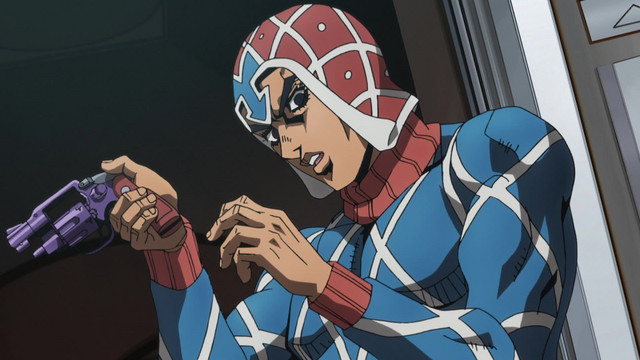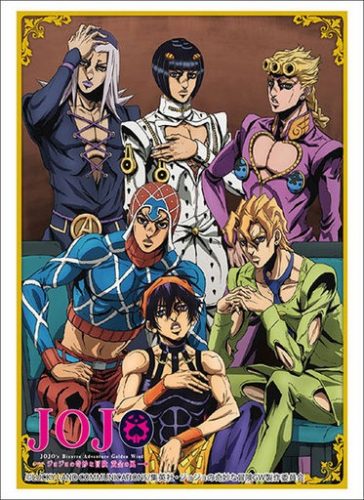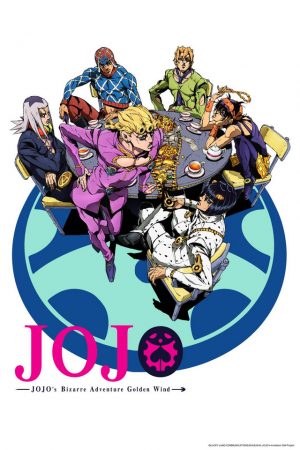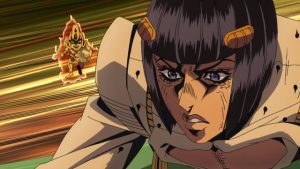
If you’ve been following Jojo’s Bizarre Adventure this season, you probably just finished the last few episodes of Golden Wind and wondered, “What the heck was that?”. It’s not exactly hard to interpret what happened either, it’s just that there’s an extremely odd cut to a seemingly unrelated stand battle Mista had in the past that predicted the deaths of Buciarrati, Abbacchio, and Narancia right after the big win against Diavolo. It kills the momentum.
It’s a perfectly straightforward sequence of events, yet fans have come out of this confused. Where was our big, long, drawn-out 1-on-1 showdown with Giorno and Diavolo after Giorno gained Golden Experience Requiem? Why couldn’t we have seen this backstory with Mista earlier? Let’s take a look!
A Quick Rundown of King Crimson and Golden Experience Requiem
It’s a real shame that King Crimson has been so hyped up as being this indecipherable ability that “just works” as the original fan translations of Part 5 have made it sound far more indecipherable than it actually is. King Crimson pauses time for its user, allows them to see 10 seconds into the future, and react within that timespan. There are some other minor rules about being able to interact with organic and inorganic material, but that’s the gist of it.
The takeaway here is that Diavolo’s power is control over fate. Diavolo’s arrogance stems from his belief that he is able to control the fate of anyone who crosses him, which allows him to build his criminal empire completely in the shadows. This is the driving conflict that puts him at odds with Buciarati’s crew (and by extension Giorno), who challenge the current order and fight against the system that Diavolo is so intent on maintaining. Giorno’s evolution of Golden Experience into Requiem is a satisfying moment of growth because his new power directly challenges that of King Crimson. Rather than seeing and controlling fate, Golden Experience Requiem allows Giorno to make his own future. In essence, fate lost to the power of humanity’s will to fight against it.
The Illusion of Free Will
Of course, just as we’re basking in Giorno’s triumph against Diavolo, we’re then immediately undercut with the sad revelation of Mista’s pointless struggle against Rolling Stone. Mista, not being the brightest guy, did not seem to understand that Rolling Stone was only foretelling Bucciarati’s fate and was not directly responsible for it. If Bucciarati were to touch it, he could have been spared a horrible, miserable death and instead would have died peacefully. However, by putting off Bucciarati’s death, he instead additionally doomed his friends Narancia and Abbacchio. He didn’t really change fate, but instead, altered its course.
The sad fact of the matter is that this story gives credence to Diavolo’s nihilistic views on fate. Afterall, the future Diavolo saw where the arrow stabbed straight through Giorno was not false; he didn’t get the full picture of it. In Rolling Stone, we see that the future was, in fact, set since the beginning of this journey and that Giorno would succeed only at the cost of his dear friends.
The Tragedy of Giorno
The comparison between Giorno and Jesus Christ is not subtle. He’s the son of DIO, or Italian for God, and fights against Diavolo, which is Italian for Devil. He “dies” in his fight against Diavolo when he gets stabbed through the hand (just think of the Golden Arrow as a nail), only for him to be reborn as a divine being.
It’s just that the Christian imagery seems a bit off considering Giorno wants to rule the criminal underworld. There’s no denying that he’s overall a net positive over Diavolo’s rule either, as at least the police will be less corrupt and drugs will no longer be sold to children. But it’s also kind of hard to ignore the fact that the entire power structure of Passione is in complete disarray now thanks to the actions of his group. It’s not just Diavolo’s defeat either; the entire assassination squad is dead, Diavolo’s personal guard is gone, there are new Capo spots available. The organization could very easily collapse now, so Giorno’s not exactly a saint for stepping in to pick up the remnants of Passione and put it back together.
But then, organized crime has never really disappeared no matter how many times a high profile gang falls apart, has it? So long as people desire drugs, there will inevitably be a supplier for them, laws be damned. While Diavolo’s stand power is something to be feared, what truly gives him power is that he’s only fulfilling a demand that society has that’s going unsatiated. He is in power because we have allowed him to be in power.
Being reminded of the inevitable deaths of our other heroes at the end of the series is exactly what gives the ending shot of Giorno in charge of Passione its power. Not only is it a reminder of better times, but it recontextualizes how we view not just their fate, but fate in general. They were fated to die, but only so Giorno could protect the world from itself. He doesn’t get a peaceful life outside of organized crime. He has to be the best of a bad situation that society has created.
Final Thoughts

While Golden Wind’s final message is one of hope, it’s not exactly an uplifting hope either. This is probably why the reception to Golden Wind’s ending is not the most positive, considering the last 3 parts all had fairly upbeat endings. But Golden Wind was never meant to be about the best of society either. Rather, it’s a more sobering look at what the best can be done given the circumstances.



